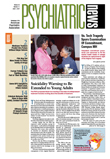The Food and Drug Administration (FDA) has asked the manufacturers of antidepressants to extend warnings about increased risk of suicidal thinking or behavior (suicidality) for antidepressant medications to include patients up to age 24. Based on a meta-analysis of clinical trials the FDA released last December, the agency said that a “slight” increase in suicidality “in early treatment” was observed in this age group.
The drug companies were asked to submit their revised product labels by June 2.
Another change that the FDA has requested—called precedent setting by some experts—is the addition of language in the labeling's black box indicating that “depression and certain other psychiatric disorders are themselves associated with increases in the risk of suicide.” No statement about the dangers of depression is included in the current version of the black-box warning for patients under age 18, in effect since 2005.
The fact that the FDA is recognizing depression as a leading risk factor for suicide at least partially counterbalances the concerns raised by the warnings on the effects of treatment.
“We were concerned about unintended consequences of the original black-box warning—people not seeking care or taking their medications or doctors not prescribing appropriate medications,” said Carolyn Robinowitz, M.D., president-elect of APA, who testified at FDA hearings last December (Psychiatric News, January 19). “We are delighted that the FDA noted in the label that untreated depression is a greater risk factor than taking antidepressants.”
The FDA also noted a slight protective effect of treatment among 25-to 64-year-olds and a more pronounced benefit for those over 65 years.
“I think that the FDA has made a historic step in emphasizing the risk of the disorder in comparison with the side effects of the drugs,” said Darrel Regier, M.D., M.P.H., director of APA's Division of Research and the American Psychiatric Institute for Research and Education, in an interview.
The FDA is also proposing another important labeling change with regard to the frequency of monitoring patients on antidepressants. The current labeling sets a monitoring standard “that has no evidence base and could be doing harm,” said Regier. That regimen, set previously at seven visits in 12 weeks, has dissuaded at least some physicians from even starting antidepressant treatment, he said. The FDA is now proposing that the labeling be changed to, “Patients of all ages who are started on antidepressant therapy should be monitored appropriately and observed closely for clinical worsening, suicidality, or unusual changes in behavior.”
APA recommends the use of accepted assessments of depressive symptoms to evaluate a patient's condition.
“In our December 2006 written and oral testimony to the FDA on the SSRI risks in adults, APA advocated for use of 'measurement-based care' with instruments like the PHQ-9 or the QIDS, used in STAR*D, rather than an arbitrary number of face-to-face visits,” said Regier. STAR*D is the acronym for the Sequenced Treatment Alternatives to Relieve Depression study.
The proposed labeling also notes that as part of the monitoring process, families of patients should be alerted to check daily for the appearance of agitation, irritability, unusual changes in behavior, and emergence of suicidality.
The current warning concerning pediatric use of antidepressants, which the FDA requested in 2004, was based on a pooled analysis of 4,400 children and adolescents in 24 short-term trials. The analysis suggested that suicidality occurred more frequently in younger patients (14 additional cases per 1,000), but declined as these pediatric patients aged. The new warning concerning young adults is based on an analysis of 77,000 adult patients, which showed a slight increase among those 18 to 24 years old (an additional 5 cases per 1,000) and decreases in drug-related suicidality among older patients.
The FDA's proposed labeling notes that no one in the pediatric trials committed suicide. “There were suicides in the adult trials, but the number was not sufficient to reach any conclusion about drug effect on suicide.”
Some observers, while agreeing that patients should be closely monitored in the first month or two of antidepressant treatment, believe that the FDA's recommendation may be overly cautious, based on the evidence in its analysis. About 20 percent of the data the FDA assessed—but not included in the primary analysis—came from trials for nonpsychiatric indications (like obesity or insomnia) or for nonbehavioral diagnoses (like fibromyalgia or stress urinary incontinence), wrote Richard A. Friedman, M.D., and Andrew C. Leon, Ph.D., in a commentary published online in the May 7 New England Journal of Medicine.
“The risk per person year of treatment was substantially lower in trials for nonpsychiatric indications, suggesting that depression played a key role in suicidality and that antidepressdants do not themselves generate new suicidal symptoms,” wrote Friedman and Leon. “The real killer in this story is untreated depression, and the possible risk from antidepressant treatment is dwarfed by that from the disease.”
Many experts, in and out of the FDA, agreed that patients starting antidepressant treatment should be carefully followed.
“Every psychiatrist knows that these drugs can be quite powerful, and one must be alert to idiosyncratic responses including agitation, sleeplessness, and suicidal thoughts,” said Robin Weiss, M.D., a past president of the Maryland Psychiatric Society and a child and adolescent psychiatrist in private practice in Towson, Md. “We have also all seen what seem to be impressive responses. We need better science to know exactly how effective antidepressants really are in various age groups. We need better medical care so that these drugs are used in the context of psychotherapy, education, compassion, and close monitoring.”
The agency is requiring manufacturers to provide a medication guide to be handed out with each prescription filled. The guides should be available in several months, according to the FDA (Psychiatric News, January 5).
The FDA's proposed revisions to antidepressant labeling is posted at<www.fda.gov/cder/drug/antidepressants/antidepressants_label_change_2007.pdf>.▪
